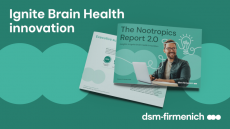‘A wake-up call to American healthcare policy makers’: Report highlights billions in potential savings from supplements

The “Supplements to Savings: U.S. Health Care Cost Savings from the Targeted Use of Dietary Supplements, 2022-2030” report by the Council for Responsible Nutrition (CRN) Foundation covers the potential healthcare costs savings associated with calcium and vitamin D, vitamin B, soluble fiber, omega-3, vitamin K2, magnesium, probiotics, lutein and zeaxanthin, and choline in the context of Coronary artery disease (CAD), osteoporosis, age-related macular degeneration (AMD), cognitive decline, irritable bowel syndrome, and childhood cognitive development disorders.
The report also details the intake levels needed to realize the additional billions in healthcare savings.
“This report is a wake-up call to American healthcare policy makers,” said Michael Meirovitz, director of government relations at CRN. “We must shift our public policy and healthcare spending priorities so American taxpayers can have better health—and pay less for it.”
Data
In the U.S., 75% of health care dollars go to the treatment of chronic disease, with only 3% spent on prevention, according to the Centers for Disease Control and Prevention (CDC). In addition to healthcare spending, these chronic diseases cost the U.S. more than $260 billion annually in lost workforce productivity.
“When it comes to healthcare spending for chronic disease, an ounce of prevention is worth billions of pounds of cure,” added Meirovitz.
The report was investigated and written by research firm Frost & Sullivan. The research methodology is a cost-benefit analysis comparing disease-attributed risk and implied associated costs in dietary supplement users vs. non-users; and meta-analyses of clinical research studies for dietary supplement ingredients as they relate to reducing the risk of a given condition. Cost savings were determined by using data including target population size, risk reduction of population, and the number of possible avoided events from supplement use.
For CAD, in people 55 and over, the report identified omega-3s (1,000 mg), magnesium (400 mg), soluble fiber (25 grams), and vitamin K2 (125 or 90 micrograms), with potential cost savings of between $13 and $84 billion still to be realized.
For Osteoporosis in over 50s, the key supplements are calcium (1,000 mg) and vitamin D (15 micrograms), with potential unrealized costs savings of $155 billion.
Lutein (10 mg) and zeaxanthin (2 mg) supplements for people over 44 for AMD could yield unrealized costs savings of $943 million, said the report.
Probiotics for IBS in adults could deliver unrealized costs savings of $95 billion.
“Identifying at-risk populations early and providing targeted nutritional interventions like dietary supplements is a cost-effective approach alongside other healthy habits,” said Andrea Wong, Ph.D., senior vice president of scientific and regulatory affairs at CRN. “A steadily growing body of clinical research shows investing in preventive care through supplementation helps Americans avoid chronic conditions. This strategy is what we call a no-brainer.”
The complete “Supplements to Savings” economic report can be downloaded at www.SupplementsToSavings.org.
Spreading the word…
CRN confirmed it plans to share the report and its findings with all stakeholders in the healthcare industry, including medical professionals, insurance providers, policymakers, and consumers. “It is important for as wide an audience as possible to understand both the risk reduction and cost savings achievable with use of dietary supplements,” said CRN.















